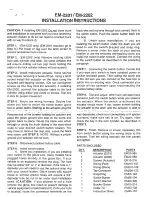
© 2017 DMF, Inc. All Rights Reserved.
Page
4
of
5
*STEPS 7-9 REQUIRE SPECIALIZED EQUIPMENT OR SOFTWARE. *
7.
Change Speedometer Calibration
a.
The suggested 19.5” tires have a larger rolling diameter than the tires found on most “work
truck” trim level vehicles.
b.
Ford Dealership Service Center:
The speedometer calibration is limited to stock tire sizes. As the
tires we recommend are not a stock size for this vehicle, the stock LT265/60R20 tire setting
should be selected as it is the most comparable in size.
c.
Using FORScan Software:
The speedometer calibration can be adjusted to more accurately
reflect the installed tires using freely available FORScan software and a supported OBDII interface
adapter.
See DMF TRB0012 for detailed information.
8.
Change TPMS Threshold Pressures
a.
The suggested cold inflation pressure of 85 psi is higher than factory tires, which can cause errant
TPMS warnings if the system threshold pressures are not adjusted.
b.
Ford Dealership Service Center:
Typical factory cold inflation pressures are 75F/80R. Dealerships
are unable to set cold inflation pressures above 80 psi. Installer testing and verification may
show this to be an adequate setting to comply with the FMVSS 138 requirements for TPMS
telltale indicator illumination.
c.
Using FORScan Software:
Cold inflation pressures can be set to 85 psi using freely available
FORScan software and a supported OBDII interface adapter. Road testing by DMF has shown this
this procedure typically complies with FMVSS requirements, but certifying compliance of the
completed vehicle is the responsibility of the installer.
See DMF TRB0012 for detailed
information.
9.
“Re-Learn” New TPMS Sensors
a.
The TPMS system will not operate properly until the new sensors are paired with the vehicle.
b.
2017+ models should “re-learn” sensors/locations automatically within several miles of driving.
c.
If automatic pairing is unsuccessful, factory tools and techniques for TPMS re-learning may
provide better results.
10.
Testing
a.
It is the responsibility of the installer to certify that the truck complies with all applicable State
and Federal regulations.
b.
In particular, the regulations and test procedures outlined in FMVSS Standard 138 must be
performed in order to ensure compliance.
11.
Inspection & Maintenance
a.
Visually inspect wheels & tires both prior to and after use on rail (look for damage, loose
hardware, etc.)
b.
Check the fastener torque 50 miles after wheel/tire change and every 2000 miles or 6 months.
Summary of Contents for RW-1016
Page 22: ......
Page 30: ......
Page 46: ......
Page 47: ......
Page 48: ......
Page 54: ......
Page 55: ......
Page 56: ......
Page 59: ......
Page 60: ......
Page 97: ...2017 DMF Inc All Rights Reserved Page 4 of 4 Page left intentionally blank...
Page 102: ...2017 DMF Inc All Rights Reserved Page 5 of 5 Page left intentionally blank...
Page 107: ...2017 DMF Inc All Rights Reserved Page 5 of 5 Page left intentionally blank...
Page 110: ...DIVERSIFIED METAL FABRICATORS INC RW 1016 2017 DMF Inc All Rights Reserved...










































